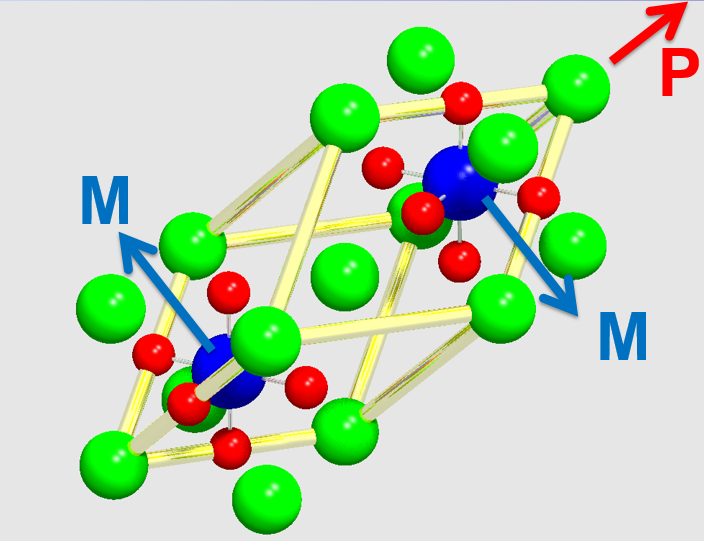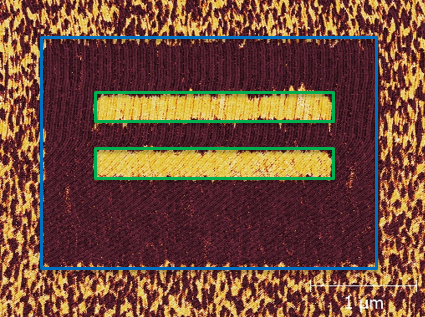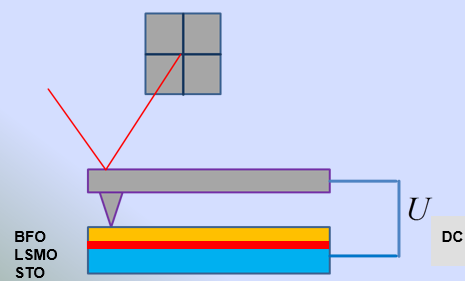Using voltages and electric fields instead of magnetic fields or electric currents is a new approach to control the spin in solids. Multiferroic materials exhibiting magnetic and electric ferroic order offer a unique possibility to change the orbital quantization axis of the spin by an electric field. Due to the fact that only a voltage is applied but no current flow is needed (aside from the charging current) high speed switching at very low dissipation levels can be realized in scalable device architectures.
We use multiferroic BiFeO3 (BFO), which is a ferroelectric and an antiferromagnet, in combination with a ferromagnetic overlayer, as a model system to realize emergent spin phenomena and to modify the spin state by an electric field. The antiferromagnetic layer couples via the exchange interaction to the spins of the neighboring ferromagnetic layer, which acts as a detector for the magnetization direction.

Using Pulsed Laser Deposition we create epitaxial thin film heterostructures of multiferroic BFO and magnetic oxides. These thin films structures are ideal candidates for investigation of the physical properties and will be required for applications in magnetic memory systems. The ferroelectric properties of the thin film structures are demonstrated by piezo force microscopy, where the polarization state is written and read by an atomic force microscope with a conducting tip (Piezo Force Lithography) on a nanoscale.


Our investigations of x-ray resonant magnetic reflectometry (XRMR) and transmission electron microscopy (TEM) on SrTiO3-BiFeO3-La0.67Sr0.33MnO3 (STO-BFO-LSMO) and STO-LSMO-BFO samples question the validity of the published model based on orbital hybridization. With the spectroscopic method XRMR we are sensitive to the element specific magnetic moments. We found an induced ferromagnetic Fe moment in the BFO only for the rough interface with LSMO, while it is absent in the sharp interface. This finding is corroborated by measurements of the exchange bias on a larger number of samples. The reason for this discrepancy to the results from other groups is not clear yet. However, as we find the magnetic coupling in the sample with the rough interface, insufficient sample quality of our samples can be ruled out.

Other pathways we follow is to use a gate oxide layer with either a high dielectric constant (HfO) or one that allows to change its oxidation state based on the applied voltage (GdOx). Both these aspects are embedded in the Marie Curie International Training Network MagnEFi (Magnetism and Electric Fields) where we join efforts from 15 PhD projects dirstributed over 7 European countries to establish new spintronic devices.
One project is done at the JGU JGU II: Ferroelectric gating of the antiferromagnet /ferromagnet coupling
while we strongly cooperate with the company Singulus on Advanced Materials Deposition.
For a more detailed view of the field see:
Perspective: Magnetoelectric switching in thin film multiferroic heterostructures
Peter B. Meisenheimer, Steve Novakov, Nguyen M. Vu, and John T. Heron
Journal of Applied Physics 123, 240901 (2018); DOI-Link 10.1063/1.5031446
Our work in the field is published as:
The challenges in realizing an exchange coupled BiFeO3 – double perovskite ferrimagnet bilayer
Sven Becker, Sven Heinz, Mehran Vafaee, Mathias Kläui, and Gerhard Jakob,
J. Mag. Mag. Mater. 506, 166766 (2020), doi: 10.1016/j.jmmm.2020.166766
Large modulation of perpendicular magnetic anisotropy in a BiFeO3/Al2O3/Pt/Co/Pt multiferroic heterostructure via spontaneous polarizations
P. F. Liu, J. Miao, Z. D. Xu, G. Jakob, Q. Liu, Z. Y. Ren, K. K. Meng, Y. Wu, J. K. Chen, X. G. Xu, and Y. Jiang,
Appl. Phys. Lett 113, 1062401 (2018); doi: 10.1063/1.5040876
The effect of interface roughness on exchange bias in La0.7Sr0.3MnO3 - BiFeO3 heterostructures
Mehran Vafaee, Simone Finizio, Hakan Deniz, Dietrich Hesse, Hartmut Zabel, Gerhard Jakob, and Mathias Kläui
Appl. Phys. Lett. 108, 072401 (2016); http://dx.doi.org/10.1063/1.4941795
Electric field modification of magnetotransport in Ni thin films on (011) PMN-PT piezosubstrates
A. Tkach, A. Kehlberger, F. Büttner, G. Jakob, S. Eisebitt, and M. Kläui,
Appl. Phys. Lett. 106, 062404 (2015); http://dx.doi.org/10.1063/1.4907775
Conductance control at the LaAlO3/SrTiO3-interface by a multiferroic BiFeO3 ad-layer
C. Mix, S. Finizio, M. Kläui, and G. Jakob,
Appl. Phys. Lett. 104, 262903 (2014); http://dx.doi.org/10.1063/1.4886405
Direct observation of temperature dependent magnetic domain structure of the multiferroic La0.66Sr0.34MnO3/BiFeO3 bilayer system by x-ray linear dichroism- and x-ray magnetic circular dichroism-photoemission electron microscopy, microscopy,
C. Mix, S. Finizio, M. Buzzi, F. Kronast, F. Nolting, G. Jakob and M. Kläui,
J. Appl. Phys. 115, 193901 (2014); http://dx.doi.org/10.1063/1.4876300
Magnetic domain structure of La0.7Sr0.3MnO3 thin-films probed at variable temperature with Scanning Electron Microscopy with Polarization Analysis
R. M. Reeve, C. Mix, M. König, M. Foerster, G. Jakob, and M. Kläui,
Appl. Phys. Lett. 102, 122407 (2013), http://dx.doi.org/10.1063/1.4798538
Multiferroic and structural properties of BiFeO3 close to the strain induced phase transition on different substrates
C. Mix and G. Jakob,
J. Appl. Phys. 113, 17D907 (2013); http://dx.doi.org/10.1063/1.4795216
Magnetism of Co doped ZnO thin films
M. Gacic, G. Jakob, Ch. Herbort, H. Adrian, T. Tietze, S. Brück, and E. Goering,
Phys. Rev. B 75, 205206 (8 pages) (2010), http://dx.doi.org/10.1103/PhysRevB.75.205206